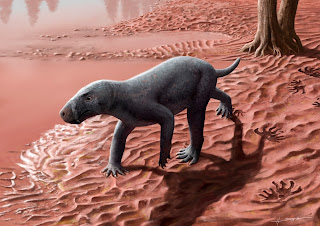Reconstruction of the appearance in life
of a gorgonopsian in a floodplain of the Permian of Mallorca. Credit: Henry
Sutherland Sharpe
An
international research team led by the Institut Català de Paleontologia Miquel
Crusafont (ICP) and the Museu Balear de Ciències Naturals (MUCBO | MBCN) have
described a fossil animal that lived between 270 and 280 million years ago in
present-day Mallorca.
The discovery is exceptional, not only
because of the number of fossil remains found, but also because it is the
oldest known gorgonopsian on the planet, the lineage of saber-toothed predators
that would eventually give rise to mammals. The research has been published in
the journal Nature Communications.
Gorgonopsians are an extinct group of
synapsids that lived during the Permian, between 270 and 250 million years ago.
They belong to the evolutionary lineage that would give rise to the first
mammals 50 million years later.
They were warm-blooded animals like
modern mammals, but, unlike most of them, they laid eggs. They were carnivorous
and were the first animals to develop the characteristic saber teeth. They were
often the superpredators of the ecosystems in which they lived, and their
appearance would be similar to a dog, but without ears or fur.
The remains recovered in Mallorca belong to a small to medium-sized animal, approximately one meter in length, and come from a site located in the municipality of Banyalbufar (Serra de Tramuntana, Mallorca). Excavations were carried out in three different campaigns during which a large quantity of material was recovered.
Credit: Anna Solé / Institut Català de
Paleontologia Miquel Crusafont
"The large number of bone
remains is surprising. We have found everything from fragments of skull,
vertebrae, and ribs to a very well-preserved femur. In fact, when we started
this excavation, we never thought we would find so many remains of an animal of
this type in Mallorca," explains Rafel Matamales, curator of the Museu
Balear de Ciències Naturals (MUCBO | MBCN), research associate at the ICP, and
first author of the article.
Its location in the Balearic
Islands is an unusual fact in itself. The known remains of gorgonopsians prior
to this discovery belonged to very high latitudes such as Russia or South
Africa. Its age has also surprised the researchers who conducted the study.
"It is most likely the oldest gorgonopsian on the planet. The one we found in Mallorca is at least 270 million years old, and the other records of this group worldwide are, at the very least, slightly younger," points out Josep Fortuny, senior author of the article and head of the Computational Biomechanics and Evolution of Life History group at the Institut Català de Paleontologia Miquel Crusafont (ICP).
The silhouette of the described animal
showing the different anatomical elements recovered during the excavation.
Credit: Eudald Mujal / SMNS
Among
the excavated fossil remains, a nearly complete leg stands out, which has
allowed researchers to study how the animal moved. Unlike reptiles, which have
a more ancestral locomotion with their legs more spread out, gorgonopsians had
their legs positioned more vertically and, therefore, moved in a way that was
intermediate between reptiles and mammals. This system is more efficient for
walking and especially for running.
The recovered saber teeth confirm its diet. "We know that this is a carnivorous animal, a characteristic shared by all gorgonopsians worldwide. The saber teeth are a common feature in large predators of ecosystems, and what we have found was likely one in the environment in which it lived," emphasizes Àngel Galobart, researcher at the ICP and director of the Museu de la Conca Dellà.
Saber tooth of the gorgonopsian (cast). Credit: Anna Solé / Institut Català de Paleontologia Miquel Crusafont
Postcranial elements of the gorgonopsian
from Mallorca (cast). Credit: Anna Solé / Institut Català de Paleontologia
Miquel Crusafont
Left femur of the gorgonopsian from
Mallorca (cast). Credit: Anna Solé / Institut Català de Paleontologia Miquel
Crusafont
When Mallorca was not an island
During the Permian, approximately
270 million years ago, Mallorca was not an island but was part of the
supercontinent Pangea. It was located at an equatorial latitude, where
countries like Congo or Guinea can be found today. The climate was monsoonal, alternating
between wet and very dry seasons.
It has been found that the site
where the fossils were found was a floodplain with temporary ponds where
gorgonopsians and other fauna drank. Among the animals that cohabited in this
ecosystem were moradisaurine captorhinids, an ancient group of herbivorous
reptiles to which the Tramuntanasaurus
tiai belongs,
which may have been part of the gorgonopsians' diet.
Despite the small area that they
occupy, the Balearic Islands have an exceptional fossil record. The most
studied and well-known fossils are from the Pleistocene and Holocene.
However, the fossil record from other periods is considerably less known. Nonetheless, remarkable fossils have been found, such as the world's oldest mosquito, nearly a thousand species of ammonoids (cephalopods related to squids), ancestors of horses and hippos, giant sharks, and large coral reefs.
by Miquel Crusafont Catalan
Institute of Paleontology
Source: World's oldest mammalian ancestor discovered in Mallorca





No comments:
Post a Comment